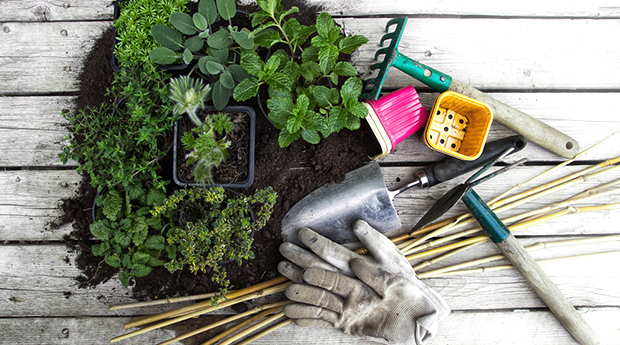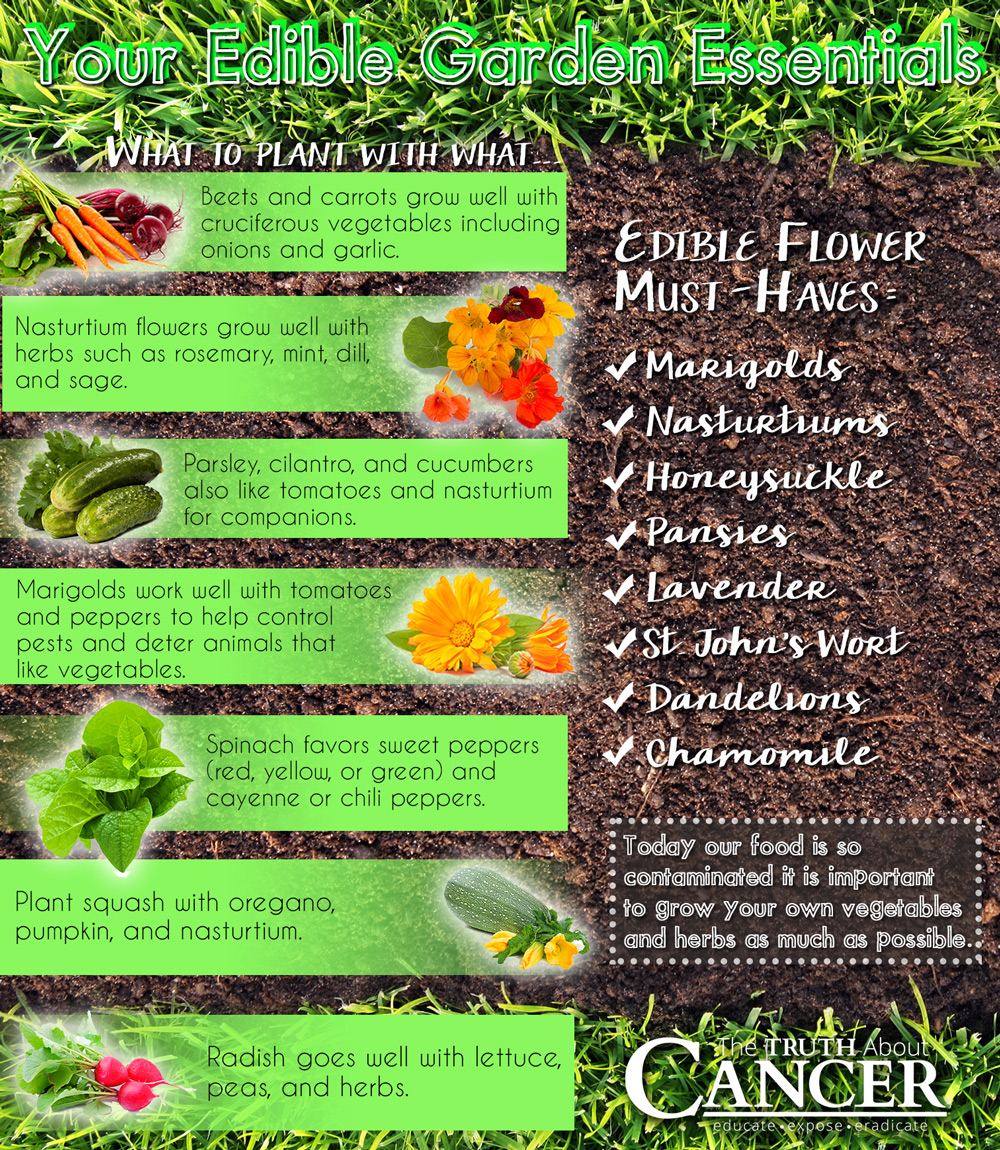When you think of a landscape, do thoughts of relaxing in a beautiful, fragrant, well groomed backyard with a patio and lounge chairs come to mind? And when you envision a vegetable garden, do you see rows of tomatoes, peppers, lettuce, squash, and so on?
Well, what if you could put the two together and create a beautiful but practical “gardenscape”? That’s the idea behind the edible landscape. It’s a strategic blend of edible plants, flowers, herbs, and trees in a money saving, healthy garden that can be enjoyed in many ways.
Some of the benefits of an edible landscape include gathering fresh fruits, vegetables, and herbs for your anti-cancer pantry while also experiencing the therapeutic beauty of the plants.
Beauty helps you to relieve stress which reduces the risk of cancer and other chronic illnesses. Fresh air is another benefit. But the greatest reward is the quality and flavor of your own veggies. Homegrown produce offers nutrient dense food that cannot be compared with store-bought. Organic vegetables from your own garden are even superior to those from an organic farm because nutrients begin to diminish in potency as soon as produce is harvested.
So, the idea is to minimize the time it takes to gather the produce and get it to the table for eating.
The garden is a work of art when you mix edible flowers with vegetables, fruit, and nut trees, berry bushes, and vines with arbors. It is an exciting venture to design and implement the edible landscape. You benefit in many ways… you get to eat the plants, enjoy their beauty, smell their fragrance, and eliminate pests naturally.
You also save money both by not spending it on mowing a useless lawn, and saving it by growing your own food. This topic is diverse so I will try to keep it focused as a guideline with general tips. I will let you fill in the specifics for your preference of food plants and color combinations that fit in your growing zone. I find growing edible plants that also have beauty to be very rewarding, and I think you will too.
Steps to Creating Your Edible Landscape
First, it is important to map out your available growing area and then design it to fit your style of garden. It can be as simple as inter-planting lettuce, cabbage, strawberries, and root vegetables in a combined border with edible flowers like nasturtium, roses, pansies, tulips, mustard, and marigold.
Behind these plants you can mix shrubs of berries, bush varieties of squash, eggplant, cucumber, and pumpkin.
Then there’s the climbing plants that need a pole like peppers and tomatoes. Finally grape vines look great with an arbor for a patio area, mixed with sweet smelling roses.
You can get really creative by adding a small waterfall fish pond with your herbs around it. The water would get circulated by the self-feeding waterfall pump system. Or, you could irrigate the area and then have it constantly flowing from a water source that is timed to go through drip lines and then flow back into the waterfall when the garden has enough water. The possibilities are endless and so versatile that they fit any budget and every taste.
Moreover, there are hundreds of plants available that are organic. You can even collect the seeds from some plants by allowing them to mature into the seed stage and then plant them the following year.
So, first you design the available space and then determine your growing zone. After that choose the plants you like to eat, and finally add in the companion planting ideas to mix edible and ornamentals. Or you can just use edibles − there is plenty of variety to fill every space.
Finally design the area so that tall plants won’t shade shorter plants, and organize them according to the movement of the daily sun exposure.
A Sample Garden Step-by-Step
Suppose you have your kitchen facing the back yard with a patio attached to the house behind the kitchen. When you look out the window you can see the lawn area with a couple of your favorite dwarf fruit trees. Take a garden hose or two and some rope to map out the area that you want to plant with dwarf trees, vegetables, herbs, and edible flowers.
Suppose you already have bushes along the boundary line of your backyard and you want to extend the planting area in front of them. Then take your garden hose and map out the area by laying it down in front of the plants to determine how it will look. Next go back to the patio or kitchen window to observe it from a different angle. If you like the design, draw it out on copy paper allowing yourself to be flexible to make changes later.
Then make a list of the vegetables, trees, and flowers you want to grow. Get some garden and flower magazines. Cut out pictures of those plants and flowers and place them in the area that you mapped out on the paper. Post it on the wall or refrigerator for a day or two and look at the colors and see if you like the design.
Once you are satisfied, it is time to find an organic nursery. Purchase the plants and organic plant-based compost and humus like peat moss or a blend. Then schedule a time when it is to be a cloudy, partly rainy day to plant your garden.
Perhaps you have some friends that like to garden that you can invite to help you prepare the ground and put the plants in.
Now some tips on what goes where. Try to include types of plants that have powerful anti-cancer benefits, plants that naturally grow well together, ones that deter pests and so on. Here are some guidelines to help you get started.
Anti-Cancer Garden Essentials
Turmeric is a very important antioxidant for repairing damaged tissue, and can be grown with the herbs. It also purifies the blood and acts as an anti-inflammatory spice. If you have a water feature in the garden it would work well there as it needs plenty of water.
Ginger goes well with turmeric and also needs plenty of water. It is another anti-inflammatory herb with a wide array of benefits. From teas to smoothies, you always need fresh ginger.
Dwarf apricot trees are an excellent choice for the garden. The fruit and inner kernel have special benefits to fight cancer.
Black cherry trees are beautiful and the sweet cherries are potent anti-inflammatory, anti-oxidant fruits that go well with salads and in smoothies.
Maple walnut trees should be grown in an area away from the other vegetables and herbs because they affect the soil in such a way as to hinder vegetable growth. The nuts can be harvested and eaten in the fall. They are good for the brain, liver detoxification, and other anti-cancer benefits.
Companion Planting in Your Edible Landscape
Some plants naturally grow better when they are with certain other plants. This is called companion planting. Some examples include:
- Spinach favors sweet peppers (red, yellow, or green) and cayenne or chili peppers
- Marigolds work well with tomatoes and peppers to help control pests and deter animals that like vegetables
- Beets and carrots grow well with the cruciferous vegetables including onions and garlic
- Nasturtium flowers grow well with herbs such as rosemary, mint, dill, and sage
- Parsley, cilantro, and cucumbers also like tomatoes and nasturtium for companions
- Squash likes oregano, pumpkin, and nasturtium
- Radish goes well with lettuce, peas, and herbs
This is a short list of some of the most common choices for an herb and vegetable garden. There are many options to choose from so I added a source below for more ideas.
Edible Flowers
The reason to consume edible flowers are for their trace minerals, vitamins, and added pizazz in your culinary arts. Their natural beauty enhances the garden while their flavor adds variety to the palate and offers medicinal value at the same time. I have listed below some of the most popular edible flowers, but there are many more. Check the Sources & References (under the article) for options and precautions:
- Marigolds: French marigold and Calendula “pot marigold” has a peppery flavor and range in color from gold to red. They can be used in salads and soups, and dried as a spice.
- Nasturtiums come in a variety of colors ranging from orange to red. The leaves, flower, and seeds are all edible with a pungent peppery flavor similar to arugula (herb also known as rocket).
- Honeysuckle is a nice vine bush type plant with a wonderful fragrance. The flowers are yellow and white and taste mildly of honey.
- Pansies are pretty as border plants and have a mild flavor that is nice in a salad.
- Lavender is a sweet smelling herb with a pretty purple flower that can be used in aromatherapy and sparingly in some recipes. It looks beautiful in the garden with other herbs.
- St. John’s Wort is an herb that works as an anti-inflammatory, blood purifier, and liver detoxifier. It’s pretty yellow flowers look great in the garden from early to mid-Spring. These should be collected and dried, stem and all, in a cool dry place to be used for tea. The tea also helps to enhance one’s mood.
- Dandelion flowers are known for their anti-inflammatory, detoxification, and blood purifying properties and have a mildly sweet flavor. The root can be dried and ground for a coffee substitute.
- Chamomile is another flowering herb with white petals and yellow center. It grows in late spring to early summer. The flowers can be dehydrated in a cool dry place for tea. The tea helps digestion, calms the nerves and alleviates anxiety, aides in sleep, and reduces depression.
Natural Pest Deterrents
Marigolds are known to protect plants from animals such as ground hogs. The also protect against various insects that bother tomatoes and vegetables from the cruciferous family (kale, cabbage, broccoli, cauliflower, and Brussels sprouts). The French variety are the best for combatting the nematodes that attack the tomato roots so without a lot of soil testing it is a good idea to get the Tagetes patula (French marigold).
Marigolds are also edible so it is a good idea to use them for a border in front of tomatoes, cabbage family, and peppers. Their flavor is strong so you might want to plant some calendula variety as well for use in salads and edible garnishes for their milder flavor.
Stinging nettles are good to repel animals and certain insects. They can be dried for tea or used raw in a smoothie after rinsing in cold water. They have a long list of unique anti-cancer benefits including boosting the immune system and detoxing the liver and blood. Most people see them as weeds, but they are powerful healing herbs.
Garlic and garlic chives also repel insects and some animals because they don’t like the smell so it helps mask the more desirable plants.
A Few Closing Tips & Benefits of Your Edible Landscape
Gardening and landscaping may sound like a lot of work but the benefits are worth it. Our food supply is contaminated so it’s important to grow your own vegetables and herbs as much as possible.
It really makes a difference when you’re able to get fresh organic produce from the garden to your dinner table because you minimize the loss of nutrients. It’s also important to fortify the soil with organic plant-based compost instead of animal manure because commercially raised animals produce manure that is full of chemical toxins from GMOs, bacteria, and heavy metals that you don’t want in your garden.
You also want to use organic pest control because you want to avoid the carcinogenic poisons found in common pesticides.
Last, but certainly not least… the emotional effects of a beautiful garden that provides both food and relaxation is priceless. Working in the garden is very therapeutic for the mind and soul, which helps to keep you healthy and cancer free!
Article Summary
What’s an edible landscape? It’s a strategic blend of edible plants, flowers, herbs, and trees in a money saving, healthy garden that can be enjoyed in many ways.
Some of the benefits of an edible landscape include gathering fresh fruits, vegetables, and herbs for your anti-cancer pantry while also experiencing the therapeutic beauty of the plants.
First you design the available space and then determine your growing zone. After that choose the plants you like to eat, and finally add in the companion planting ideas to mix edible and ornamentals. Or you can just use edible plants as there are plenty to choose from.
Try to include plants that have powerful anti-cancer benefits, plants that naturally grow well together, ones that deter pests and so on.
Some plants naturally grow better when they are with certain other plants. This is called companion planting.
Edible flowers not only enhance your garden with their natural beauty. They are also beneficial for their trace minerals, vitamins, and for adding pizazz in your culinary arts.
The emotional effects of a beautiful garden that provides both food and relaxation is priceless. Working in the garden is very therapeutic for the mind and soul, which helps to keep you healthy and cancer free!




















Debbie wonderful wonderful but I live in Ukraine on the 9th storey c an you help me plan what to grow on my indoor balcony? I am a recovering breasst canc er person, I am a wild food lover. Thank you
Debbie as someone that grew up in Easter Europe we utilized lot of the wild food such as mushrooms, linden flowers and leaves, dandelion leaves, nettles, Chamomile flowers that grew everywhere. Perhaps foraging is a better option for you, though growing herbs on your window and perhaps a tomatoes 🍅 plant are also good options.
It is much better to grow your own fruits, vegetables, herbs, and flowers, because at least you know that chemicals are not sprayed on them and you know where they come from. With fruits, vegetables, herbs, and flowers that are bought in the stores, one does not know what poisonous toxics were sprayed on them. One is most likely to become less ill, if one grows his or her own garden.
Hello Ty. Thank you for all the work that you have put in the global quest and the live symposium. I live in Brisbane Australia. Because of the time difference, i couldnt watch most of the series, but have an idea about the knowledge you have imparted to the lay people. I cannot pen down my story because its a long one. I am an RA survivor. 75% disabled. Almost thought that i was going to die. I was heavily drugged. Was even given methotrexate. These drugs nearly killed me. I was blessed that i met Dr. John Green, who helped me see the positive side if life, gave me a lot of books to read. Basically what animal protein, processed food, sugar, oil, table salt, the food that are available at the counter in the supermarkets do to our human bodies. We do not eat real food. I did a toxicity test, which then was not done in australia. My hair sample was sent to USA. The results were shocking. When time permits i will put down my story in detail. I am all well now. All my pain gone. No medication whatsoever for 9 years now. I remained vegan for 8 years and recently started having organic home made yogurt. I grow my own veggies. And have a sustainable organic permaculture garden in my appartment.
God bless you Ty and your team for all the good work that you are doing
La
Thank you for the articles. You are very generous to provide this information for subscribers. And your information is spot on. Thank you!
I would like to direct your attention to the book by Christiane Maute “Homeopathy for Plants”. This book is my “bible” for organic pest control. It is available on Amazon.
I am really entuised with your teachings I am an African specifically Ghana where we have the lands, greens and good rainy season to give us all we need but unfortunately wider preference are given to the junk food rather than our natural veggies and herbs that our grandparents heralded to their strength and healthy long life.l count it a great privilege to have all the resources made available on your page l will practise them .God bless you abundantly.
Hi Ellen –
Thank you for reaching out to us.
Though this is sad to hear, it is (unfortunately) the case for many around the world. We appreciate you sharing this with us.
And we’re happy to have helped you in any way. 🙂
Wishing you and your family good health always!